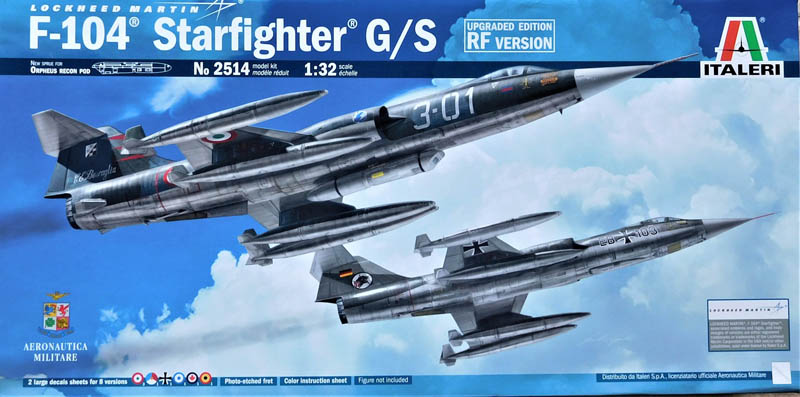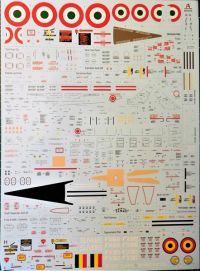Italeri | 2514: 1/32 F-104 Starfighter G/S (RF Upgraded Version)
Reviewed by Dave Williams

Italeri’s kit #2514 is the latest boxing of their 1/32 F-104 Starfighter kits. The kit is the same as their original #2502 F-104 G/S kit with the addition of a small extra sprue for RF-104 options and different markings. Other than the added sprue and new decals, the remainder of the kit is identical to the earlier kit reviewed on LSP.
The RF-104G was a reconnaissance version of the Starfighter and existed in a couple of configurations. The typical factory configuration had three KS-67A Trimetrogon cameras a shallow belly fairing behind the nosewheel bay. The 20mm cannon was deleted and the former ammunition bay was used to house the camera, as well as an additional fuel tank. The nose gear doors were normally fitted with triangular aerodynamic fairings that faired into the front of the camera fairing when the doors were closed. Although a neat and compact package, the camera system was limited to daylight/clear weather only. The other common configuration for RFs was an external Orpheus pod containing five cameras and an infrared (IR) linescan sensor, mounted on the centerline pylon. This was a much more capable system than the original internal camera system, but had the disadvantage of carrying a large, draggy external pod. The RF versions were used mainly by Germany (Luftwaffe, Marineflieger), Italy (AMI) and the Netherlands (KLu). Canadian CF-104s could carry the external Vicon reconnaissance pod, but were not designated RF. Due to varying operation needs, over the history of the F-104 some RFs built with the internal camera system had the system removed and were converted to carry the external Orpheus pod, which others were converted to normal F-104G fighter bomber configuration. Similarly, some aircraft built as F-104Gs were converted to carry the external Orpheus pod during their service lives.

The new sprue this kit contains an Orpheus pod, the belly fairing and nosewheel door fairings for the typical internal camera system, and two AN/ALE-40 flare/chaff dispensers, which were used by Marinefleiger (MFG 2) and AMI aircraft late in life. The level of external detail on the Orpheus and external camera fairing are quite good, although it should be noted that all of the camera shutters are molded closed, so no clear parts are provided for the windows. Also, as the Orpheus pod is in two halves, the seam line runs across the middle of a number of the recessed camera ports. As a note, the Orpheus pod in the put is the common Italian version with a deeper front half. The Orpheus pod used by KLu RFs was different in that the diameter of the forward half was the same as the rear half. The AN/ALE-40 dispenser as used on the F-104 could carry either 15 flare or 30 chaff cartridges. In the kit, the faces of both dispensers have a 5x3 egg crate pattern, indicating they are set up for flares. My impression is that the kit module is a bit too boxy and should be not as thick as it is.
The kit contains two large decal sheets with markings for eight aircraft. Comprehensive airframe and stores stenciling is included on the sheet. The markings are:
- AMI F-104G (RF-104G Orpheus) - 132° Gruppo, 3° Stormo, "3-01", MM6529, 1983 in grey/green over aluminum camo. This aircraft was a conversion from a F-104G and retained the 20mm cannon. An additional note for AMI aircraft is that in general they were rotated to different squadrons over their long service lives, meaning that one aircraft with a particular squadron code seen at one time could be a different aircraft with the same code when seen at a later time.
- AMI RF-104G - 28° Gruppo, 3° Stormo, "3-31", MM6649, 1985 in grey/green over aluminum camouflage. Alternate low-viz squadron code for 1992. This aircraft apparently had the standard internal camera package throughout its service life.
- AMI F-104S - 10° Gruppo, 9° Stormo "Francesco Baracca", "9-41", MM6932, 1985 in grey/green over aluminum camouflage. Alternate low-viz squadron code and F-104S ASA marking for 1989.
- KLu RF-104G - 306 Squadron, "D-8145", 1978 in grey/green over grey camouflage. Note that instructions say that the underside color is aluminum, however the KLu camo used a medium grey color. The instructions say to build it with the standard internal camera fit. Although D-8145 was delivered in that configuration, it wore the original overall grey scheme at that time. All the photos I can find of D-8145 in the camo scheme show the internal camera fairing removed and carrying the external Orpheus pod. As noted previous, the Orpheus pod included in the kit is the one carried normally by the AMI, which was different than the one carried by the KLu. The correct Orpheus pod is available in resin from Videoaviation. Finally, many photos of D-8145 in camouflage show ECM antenna under the nose, which aren’t included in the kit.
- Luftwaffe RF-104G - AG 52, "EB+103", 1967 in grey/green over aluminum camouflage. The Airdoc book indicates that Luftwaffe RF-104Gs had their radars removed, so the radar scope should be removed from the instrument panel. Also, the instructions say to use aluminum for the underside, while in reality the color is RAL 9006, which can sometimes appear as more of a light grey instead of a metallic color.
- HAF RF-104G - 116 Pterix, "FG-6693", 1992 in tan/green/green over light grey camouflage. This aircraft is shown as having the original RF internal camera fit, however this is not correct. FG-6693 was previously Marineflieger aircraft 21+32 from MFG 2. In the late ’70s, MFG 2 modified the internal camera fit on their RFs. The underside now contained a KRb 6/24 camera in a deeper fairing and added an oblique KS-87B camera in the side of the fuselage. This configuration is not represented in the kit.
- RCAF CF-104 - 417 ST/R (O.T.U.), "754", 1979 in overall NMF. Note that CF-104s all used the narrow wheels and flat gear doors, whereas the instructions incorrectly say to use the bulged doors and wide wheels for all decal options. The flat gear doors as in the kit, and the wide wheels can be narrowed (as mentioned in the original review, the kit narrow wheels have the dished F-104A-D hub).
- BAF F-104G - SILVERS Aerobatic Display Team, "FX68", 1971 in green/green/tan over light gray camouflage. Red wingtip sidewinder rails. Decal sheet also contains "FX90" code, which is not mentioned in the instructions.
Conclusion
The addition of the new parts gives the modeler additional options over the first release. Some may be a little disappointed that Italeri didn’t take the opportunity to fix some of the original issues and believe they should have invested a little more time in researching a few of the decal options, but it’s still a great kit and better in most areas than the ancient Revell and Hasegawa kits.
© Dave Williams 2018
This review was published on Friday, June 22 2018; Last modified on Saturday, June 23 2018



